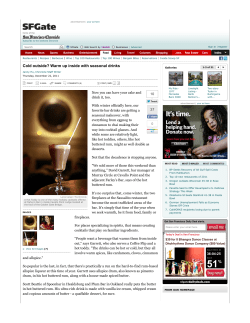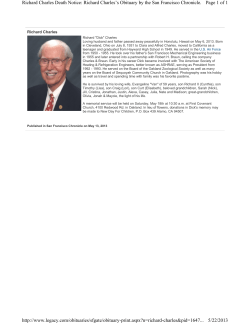
Modesto Junior College Name: MATH 134 – Fall 2011 Homework #5 Cover Sheet
Modesto Junior College Department of Mathematics Name: MATH 134 – Fall 2011 Homework #5 Cover Sheet Attach this cover sheet to your assignment. Some assigned problems are not included on the cover sheet; however, ALL assigned problems with reasoning and work shown must be attached in order to earn full credit. Please do not include odd-numbered problems from the Moore text in your homework submission. 9.2 (a) Is this an experiment? Yes / No (b) Why or why not? (c) Name the explanatory and response variables. 9.4 Identify the subjects, factors, treatments, and the response variables. 9.14 (a) Explain “double-blind”: (b) Explain “randomized”: (c) Explain “placebo-controlled”: 9.28 (a) Is this an observational study or an experiment? Why? Identify the comparison groups as part of your answer. (b) What are the explanatory and response variables? Attach answers to additional problems, #1 through #5, to the end of your homework packet, in that order. Please write legibly and coherently as homework is graded on neatness, clarity, grammar, organization, spelling and completeness. Writing that is unintelligible in either content or handwriting are not likely to be looked on favorably. 2 MODESTO JUNIOR COLLEGE Department of Mathematics MATH 134 – Fall 2011 Homework #5– Chapter 9 Due at the beginning of class on Tuesday, October 11 Problems from Moore’s text: 9.1, 9.2, 9.4, 9.5, 9.7, 9.11, 9.12, 9.13, 9.14, 9.28, 9.31 1. The requirement that human subjects must give their informed consent to participate in an experiment can greatly reduce the number of available subjects. In randomized controlled trials of treatments for cancer, for example, patients must agree to be randomly assigned to the standard therapy or to an experimental therapy. The patients who do not wish their treatment to be decided by randomization are dropped from the experiment and given standard therapy. Why is it not correct to keep these patients in the experiment as part of the control group, since the control group also receives the standard therapy? Explain briefly. 2. Some studies find a strong association between liver cancer and smoking. However, alcohol consumption is a confounding variable. (a) What does this mean? Explain briefly. (b) A newspaper writes an article about the study and titles it “Smoking causes Liver Cancer”. Is their conclusion justified? 3. In each of the following examples, thinking about the situation from the point of view of experimental design, identify the treatment and response variables; specify whether this was a controlled experiment, an observational study, or neither; visualize the raw data (by which I mean: Sketch a data table with rows for subjects and columns for ,” variables, Fill in the blank in the sentence “A row for each and (if you know something about the variable(s) in question) fill in some typical data values); Summarize the strength of evidence for the effectiveness of the treatment under study. If there is a weakness in the design, specify the weakness and describe a stronger experimental design for assessing the clinical efficacy of that treatment. (a) In the late 1970s in San Francisco, a woman named Dr. Josephine Lo and her associates treated 31 patients suffering from severe headaches resulting from spinal punctures. Conventional treatments did not help. She found that 30 of the 31 patients experienced “complete and permanent relief” after one to five acupuncture treatments. (b) One of the leading causes of death in the United States is coronary artery disease, in which the main arteries to the heart break down. The conventional treatment for this disease as of the late 1960s involved drugs and special diets to reduce the patient’s blood pressure and eliminate fatty deposits in the arteries. Several good studies, involving a few hundred patients, had reported by 1970 that about 68% of patients getting this treatment survived for three years or more. In 1972, a medical researcher named Daniel Ullyot and his associates introduced a radical new treatment, in which the diseased arteries were replaced by veins transplanted from the patient’s own legs (this procedure is called a coronary artery bypass graft (CABG); and hundreds of thousands of CABGs are now done in the U.S. every year). On December 9, 1975, the San Francisco Chronicle reported preliminary results of Dr. Ullyot’s research: about 100 patients, specially chosen by him, had been treated in the new way by then, and 98% survived three years or more. The Chronicle described these results as “spectacular.” 4. A study of young children found that those with more body fat tended to have more “controlling” mothers; the San Francisco Chronicle (November 9, 1994) concluded that “Parents of Fat Kids Should Lighten Up”. (a) Was this an observational study or a randomized controlled experiment? (b) Did the study find an association between mother’s behavior and her child’s level of body fat? (c) If controlling behavior by the mother causes children to eat more, would that explain an association between controlling behavior by the mother and her child’s level of body far? (d) Suppose there is a gene which causes obesity. Would that explain the association? (e) Can you think of another way to explain the association? (f) Do the data support the Chronicle’s advice on child-rearing? Discuss briefly. 5. Read the summary (just the first paragraph) of the journal article “What Does Doodling Do?”, attached below. (a) What is the hypothesis that the researchers are studying? (b) Are they performing an observational study or a controlled experiment? Explain. (c) What difficulties do you foresee in performing a blind experiment? (d) What do the researchers conclude? 2 MODESTO JUNIOR COLLEGE Department of Mathematics MATH 134 – Fall 2011 Homework #5– Chapter 9 Due at the beginning of class on Tuesday, October 11 Problems from Moore’s text: 9.1, 9.2, 9.4, 9.5, 9.7, 9.11, 9.12, 9.13, 9.14, 9.28, 9.31 1. The requirement that human subjects must give their informed consent to participate in an experiment can greatly reduce the number of available subjects. In randomized controlled trials of treatments for cancer, for example, patients must agree to be randomly assigned to the standard therapy or to an experimental therapy. The patients who do not wish their treatment to be decided by randomization are dropped from the experiment and given standard therapy. Why is it not correct to keep these patients in the experiment as part of the control group, since the control group also receives the standard therapy? Explain briefly. 2. Some studies find a strong association between liver cancer and smoking. However, alcohol consumption is a confounding variable. (a) What does this mean? Explain briefly. (b) A newspaper writes an article about the study and titles it “Smoking causes Liver Cancer”. Is their conclusion justified? 3. In each of the following examples, thinking about the situation from the point of view of experimental design, identify the treatment and response variables; specify whether this was a controlled experiment, an observational study, or neither; visualize the raw data (by which I mean: Sketch a data table with rows for subjects and columns for ,” variables, Fill in the blank in the sentence “A row for each and (if you know something about the variable(s) in question) fill in some typical data values); Summarize the strength of evidence for the effectiveness of the treatment under study. If there is a weakness in the design, specify the weakness and describe a stronger experimental design for assessing the clinical efficacy of that treatment. (a) In the late 1970s in San Francisco, a woman named Dr. Josephine Lo and her associates treated 31 patients suffering from severe headaches resulting from spinal punctures. Conventional treatments did not help. She found that 30 of the 31 patients experienced “complete and permanent relief” after one to five acupuncture treatments. (b) One of the leading causes of death in the United States is coronary artery disease, in which the main arteries to the heart break down. The conventional treatment for this disease as of the late 1960s involved drugs and special diets to reduce the patient’s blood pressure and eliminate fatty deposits in the arteries. Several good studies, involving a few hundred patients, had reported by 1970 that about 68% of patients getting this treatment survived for three years or more. In 1972, a medical researcher named Daniel Ullyot and his associates introduced a radical new treatment, in which the diseased arteries were replaced by veins transplanted from the patient’s own legs (this procedure is called a coronary artery bypass graft (CABG); and hundreds of thousands of CABGs are now done in the U.S. every year). On December 9, 1975, the San Francisco Chronicle reported preliminary results of Dr. Ullyot’s research: about 100 patients, specially chosen by him, had been treated in the new way by then, and 98% survived three years or more. The Chronicle described these results as “spectacular.” 4. A study of young children found that those with more body fat tended to have more “controlling” mothers; the San Francisco Chronicle (November 9, 1994) concluded that “Parents of Fat Kids Should Lighten Up”. (a) Was this an observational study or a randomized controlled experiment? (b) Did the study find an association between mother’s behavior and her child’s level of body fat? (c) If controlling behavior by the mother causes children to eat more, would that explain an association between controlling behavior by the mother and her child’s level of body far? (d) Suppose there is a gene which causes obesity. Would that explain the association? (e) Can you think of another way to explain the association? (f) Do the data support the Chronicle’s advice on child-rearing? Discuss briefly. 5. Read the summary (just the first paragraph) of the journal article “What Does Doodling Do?”, attached below. (a) What is the hypothesis that the researchers are studying? (b) Are they performing an observational study or a controlled experiment? Explain. (c) What difficulties do you foresee in performing a blind experiment? (d) What do the researchers conclude? 2 APPLIED COGNITIVE PSYCHOLOGY Appl. Cognit. Psychol. (2009) Published online in Wiley InterScience (www.interscience.wiley.com) DOI: 10.1002/acp.1561 What Does Doodling do? JACKIE ANDRADE* School of Psychology, University of Plymouth, UK SUMMARY Doodling is a way of passing the time when bored by a lecture or telephone call. Does it improve or hinder attention to the primary task? To answer this question, 40 participants monitored a monotonous mock telephone message for the names of people coming to a party. Half of the group was randomly assigned to a ‘doodling’ condition where they shaded printed shapes while listening to the telephone call. The doodling group performed better on the monitoring task and recalled 29% more information on a surprise memory test. Unlike many dual task situations, doodling while working can be beneficial. Future research could test whether doodling aids cognitive performance by reducing daydreaming. Copyright # 2009 John Wiley & Sons, Ltd. The call centre has put you on hold yet again and you start thinking about how good it would be to have a holiday, where you would like to visit . . . then you realize that the person you have been waiting to speak to has already started talking and you have not taken in anything they have said. This scenario illustrates the tendency for daydreaming to start in moments of boredom and, once started, to distract attention from the task in hand. In such a situation some people resort to doodling, aimlessly sketching patterns and figures unrelated to the primary task. It is not known whether doodling impairs performance by detracting resources from the primary task, as would be the case for the most concurrent cognitive tasks or whether it improves performance by aiding concentration (Do & Schallert, 2004) or maintaining arousal (Wilson & Korn, 2007). This question ties into more general issues in cognitive and applied psychology. Boredom is a very common experience (Harris, 2000) and daydreaming is a common response, even in the laboratory (Smallwood & Schooler, 2006). A way of aiding concentration would have implications for psychological research methods as well as practical applications. Dual task designs are commonly used to pinpoint specific cognitive resources needed to perform a task, but they fail to do this accurately if the effects of boredom are overlooked. Performance decrements through competition for task-specific resources may be moderated if the secondary task also reduces the mind-wandering or elevated arousal levels that can be a hidden feature of single task control conditions (Smallwood, O’Connor, Sudbery, & Obonsawin, 2007). This study is the first experimental test known to the author of the prediction that doodling aids concentration. Participants listened to a monotonous mock telephone message. An auditory task was chosen so that doodling would compete minimally for *Correspondence to: Jackie Andrade, School of Psychology, University of Plymouth, Drake Circus, Plymouth, PL4 8AA, Devon, UK. E-mail: j.andrade@plymouth.ac.uk Copyright # 2009 John Wiley & Sons, Ltd.
© Copyright 2025













